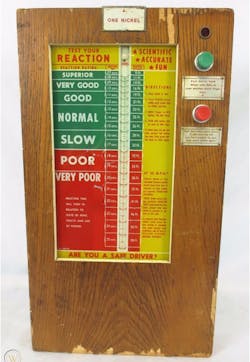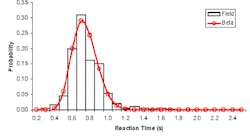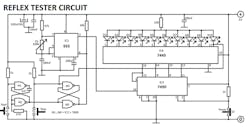Using Smartphone Texts for Clinical Reflex/Reaction-Time Tests
This article is part of the 2022 April 1st series in the Humor topic within our Series Library.
Measuring the reaction time of test subjects to random-timed stimuli is a standard clinical procedure in many settings. Modern instrumentation makes this a simple task—far more sophisticated than the “carnival” units of the 1950s (Fig. 1)—and can produce highly accurate time-data for further analysis. But setting up the test arrangement takes time while its “institutional” look can affect user comfort and thus skew results.
Now, a team at the Nation Institutes of Health (NIH) is investigating use of standard smartphones to perform the same tests. The idea is to send a text message to the test subject’s own phone and time how long it takes for them to respond, using the phone as the timer. A simple app downloaded to the phone will measure the responses and report the raw data for additional analysis (Fig. 2).
According to the project leader, people are amazingly speedy when it comes to responding to text message alerts. They can’t resist picking up the phone immediately to check. In fact, he noted that there are documented cases of individuals who were comatose yet woke up upon hearing their phone ping. In some cases, the patients even picked up their phone to answer the text message as they “snapped” out of their comatose state. An NIH spokesperson mused, not entirely in jest, “Who knows, it might even become an Olympic event in a few years?”
Use of the system based on smartphones may eliminate the need for hobbyist DIY reaction-time test circuits, such as the one built with the classic 555 timer and a few small-scale digital ICs (Fig. 3).
Read more articles in the 2022 April 1st series in the Humor topic within our Series Library.
About the Author

Bill Schweber
Contributing Editor
Bill Schweber is an electronics engineer who has written three textbooks on electronic communications systems, as well as hundreds of technical articles, opinion columns, and product features. In past roles, he worked as a technical website manager for multiple topic-specific sites for EE Times, as well as both the Executive Editor and Analog Editor at EDN.
At Analog Devices Inc., Bill was in marketing communications (public relations). As a result, he has been on both sides of the technical PR function, presenting company products, stories, and messages to the media and also as the recipient of these.
Prior to the MarCom role at Analog, Bill was associate editor of their respected technical journal and worked in their product marketing and applications engineering groups. Before those roles, he was at Instron Corp., doing hands-on analog- and power-circuit design and systems integration for materials-testing machine controls.
Bill has an MSEE (Univ. of Mass) and BSEE (Columbia Univ.), is a Registered Professional Engineer, and holds an Advanced Class amateur radio license. He has also planned, written, and presented online courses on a variety of engineering topics, including MOSFET basics, ADC selection, and driving LEDs.



